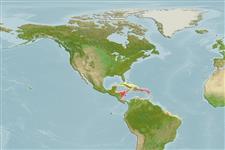Kishinouyea corbini Larson, 1980
| Native range | All suitable habitat | Point map | Year 2050 |

|
| This map was computer-generated and has not yet been reviewed. |
| Kishinouyea corbini AquaMaps Data sources: GBIF OBIS |
Upload your photos
Google image |
No photo available for this species.No drawings available for Kishinouyeidae.
Google image |
No photo available for this species.
Classification / Names Common names | Synonyms | CoL | ITIS | WoRMS
Staurozoa | Stauromedusae | Kishinouyeidae
Environment: milieu / climate zone / depth range / distribution range Ecology
Benthic. Tropical
Distribution Countries | FAO areas | Ecosystems | Occurrences | Introductions
Southwest Atlantic: Brazil (Ref. 813) and Puerto Rico (Ref. 84272).
Length at first maturity / Size / Weight / Age
Maturity: Lm ? range ? - ? cm
Short description Morphology
Nodular gonadal lobes erect, on oral surface, with broad adhesive pad-like organ on the arm tips and without an axial canal. Calyx about 15 mm maximum diameter, divided into 4 pairs of arms, resembling a cross, which is broadest near the center. Four broadly curved u-shaped perradial notches, 2x deep as the u- or v-shaped interradial notches. Arms with 6-25 short hollow capitate secondary tentacles on oral side near tip. Number and size of tentacles increase with calyx size (3 mm diameter, 9-11 tentacles; 12 mm diameter, 15-18 tentacles). Capitate ends of tentacles composed of adhesive cells. No cnidoblasts. Primary tentacles lacking in large individuals. Aboral surface smooth, without ridges or grooves, covered with numerous evenly scattered nematocyst warts. Mesoglea of aboral wall thick and less transparent than membranous oral wall. Oral surface smooth and easily folded. Numerous disc-shaped white spots on oral surface near gonads, mouth and calyx margin, i.e., vesicles, which are filled with numerous eurytele nematocysts. Manubrium short and cruciform, lips highly pleated. Pylorus of coelenteron with many (about 200) short gastric cirri. Interradial septa extend from pylorus to margin, allowing 4 radial pockets to communicate. Gonads arranged in 8 sinuous adradial bands of closely packed follicles extending from the pyloric region to the tentacles.
Green and reddish brown medusae with diffuse pigmentation. It occurs in seagrass beds. This is the only known Atlantic species of stauromedusae. Occurs in shallow algal/seagrass beds, where it can anchor with its pedal disc or arm tip adhesive organs. Feeds on small crustaceans (shrimps and amphipods; Ref. 84272) (Ref. 813).
Life cycle and mating behavior Maturity | Reproduction | Spawning | Eggs | Fecundity | Larvae
Members of the class Scyphozoa are gonochoric. Life cycle: Egg is laid by the adult medusa which later develops into a free-living planula, then to a scyphistoma to a strobila, and lastly to a free-living young medusa.
Main reference
References | Coordinator | Collaborators
Migotto, A.E., A.C. Marques, A.C. Morandini and F.L. da Silveira. 2002. (Ref. 813)
IUCN Red List Status (Ref. 130435)
CITES status (Ref. 108899)
Not Evaluated
CMS (Ref. 116361)
Not Evaluated
Threat to humans
Human uses
| FishSource |
Tools
More information
Internet sources
BHL | BOLD Systems | CISTI | DiscoverLife | FAO(Publication : search) | Fishipedia | GenBank (genome, nucleotide) | GloBI | Gomexsi | Google Books | Google Scholar | Google | PubMed | Tree of Life | Wikipedia (Go, Search) | Zoological Record
Estimates based on models
Price category
(Ref. 80766):
Unknown.


